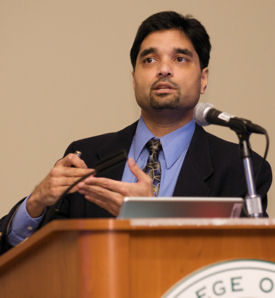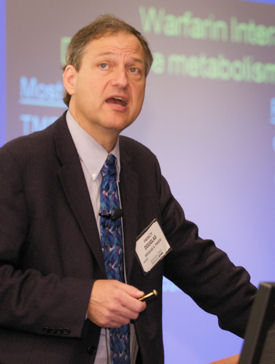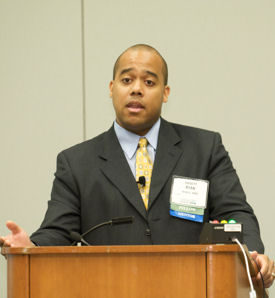New info on common outpatient infections
Expert offers recommendations on UTIs, sinusitis and MRSA.
Drainage of boils and the purulence of nasal discharge may not sound like the most appetizing of topics, but a lunchtime session on “Management of Common Outpatient Infections” attracted a large crowd at Internal Medicine 2008.
Ajit P. Limaye, MD, an infectious disease specialist at the University of Washington, updated attendees on new recommendations and evidence for the treatment of several infections commonly seen in outpatient care.
Urinary tract infections
Until recently, the management of acute uncomplicated cystitis was one of the most predictable and well-established regimens in medicine, according to Dr. Limaye. “What's changing in 2008, and over the past several years, has been that the resistance in uropathogens is increasing,” he said.
Studies have shown that among the bacteria that cause most urinary tract infections (UTI) in young, healthy women, about 30% to 40% are resistant to ampicillin and 10% to 20% are resistant to trimethoprim/sulfamethoxazole (TMP-SMX). Without a culture, it's hard to know which patients harbor a resistant strain, but researchers have identified a few risk factors—recent (within the past three months) use of antibiotics, travel or hospitalization.
“Unfortunately, even though they are epidemiologically useful, for the individual patient we don't really know what the sensitivity or specificity of those risk factors are. They can be helpful but they are not good enough to rule in or rule out,” said Dr. Limaye.
That uncertainty leaves a few options: returning to the use of cultures, treating patients based on their risk factors for resistance, or using alternative antibiotics. Bacteria that cause UTIs are much less frequently resistant to fluoroquinolones, but there is a general consensus that those drugs should be preserved for treatment of more serious infections, said Dr. Limaye.
Current recommendations suggest the use of fluoroquinolones or other non-TMP-SMX antibiotics when community resistance rates exceed 20%, but it is often difficult to know the precise rate of resistance in uropathogens within a specific community.
In many cases, however, the proper treatment will be the old standard. “Despite all of these data about resistance, for the routine patient at low risk for resistance, trim-sulfa—one double-strength BID for three days—is still considered the first-line therapy,” said Dr. Limaye.
To simplify the process even further, it may be reasonable to treat patients without even seeing them in the office. Dr. Limaye cited a 2001 study, published in the Journal of Family Practice, in which healthy, adult women who called their provider with UTI symptoms were randomized to either an office visit or telephone management by a nurse.
“The bottom line was that the success rate was very high in both arms, both in terms of clinical and bacteriologic outcomes,” he said.
Some women who have recurrent UTIs can even diagnose and treat themselves with a high success and satisfaction rate, according to another study, published in the July 3, 2001 Annals of Internal Medicine. “In selected patients, this might be a very reasonable strategy expedite therapy and potentially avoid an office visit,” said Dr. Limaye.
In contrast to symptomatic UTI, most cases of asymptomatic bacteriuria treatment do not require treatment. Patients should be screened and treated during pregnancy, before transurethral resection of the prostate, and prior to other genitourinary procedures for which mucosal bleeding is anticipated. “These are the only patient settings where one should routinely screen for and treat asymptomatic bacteriuria,” said Dr. Limaye.
There's been some controversy on this topic, but according to current guidelines, screening should not be routinely done in diabetic women, elderly patients, and people with spinal cord injury or indwelling urinary catheters. “Even if they were screened and found to have asymptomatic bacteriuria, guidelines recommend that they should not be treated,” Dr. Limaye said.
Acute sinusitis
Less treatment may also be the best practice for acute rhinosinusitis, according to Dr. Limaye. “What's new is the fact that there is quite a bit of data that now question whether antibiotics actually have a major role to play in the typical patient with this particular condition,” he said.
Most sinusitis is viral, and even most bacterial cases are self-limited, resolving within a month. Yet physicians continue to prescribe antibiotics for the condition. “Several surveys have documented that more than 90% of patients with signs and symptoms of sinusitis are treated,” said Dr. Limaye. “Recent data should make you question if that's the right thing to do.”
It's very difficult to distinguish between the viral and bacterial forms of rhinosinusitis, but a panel of experts convened in 2001 did offer some guidance, said Dr. Limaye. “One of the key features about their diagnostic criteria is that the symptoms of sinusitis that are bacterial should persist for more than seven—or some people are saying 10—days. The consideration of bacterial sinusitis shouldn't even be entertained in most people until at least 10 days of symptoms.”
Those patients also should have one of the following: purulent nasal discharge, maxillary tooth or facial pain, unilateral maxillary sinus tenderness, or worsening symptoms after initial improvement.
Even in patients who meet those criteria, antibiotics have been shown to have a very modest benefit, shortening duration by a day or so, Dr. Limaye said. The research also indicates that newer broad-spectrum antibiotics work no better than the old narrow-spectrum drugs.
“There's obvious concern about antibiotic resistance being a reason to limit antibiotics to people who really need it,” said Dr. Limaye. Those patients include ones who have moderate or severe symptoms, are immunocompromised, or have a fever over 38.5 degrees centigrade. They should receive narrow-spectrum antibiotics to start, with re-evaluation if symptoms worsen or fail to improve in a week to 10 days.
Everyone else should get observation, supportive care (including decongestants, nasal irrigation and possibly nasal steroids), and then narrow-spectrum antibiotics only if their symptoms worsen or don't improve over seven to 10 days, Dr. Limaye said.
CA-MRSA
Antibiotics should also play an adjunctive role in the treatment of community-acquired Methicillin-resistant Staphylococcus aureus (CA-MRSA). CA-MRSA first became an issue about 10 years ago when four children in Minnesota and North Dakota died after becoming infected, noted Dr. Limaye.
“The clinical manifestations in those children and in the majority of patients who develop this are skin and soft tissue infections. Fortunately, necrotizing fascitis and necrotizing pneumonia are much less common,” he said.

The disease has both different genetics and different risk factors from hospital-acquired MRSA. “It's not simply that hospital strains have gotten into the community. CA-MRSA really appears to be a different organism than hospital MRSA,” said Dr. Limaye.
People at higher risk for CA-MRSA include injection drug users, men who have sex with men, children, contact sports players, prisoners and military personnel. Infected patients are also likely to report having received a spider bite, even though research has shown no connection between spiders and the infection.
Incidence rates range from 18 to 164 cases per 100,000 in different regions of the U.S. and could go higher, according to Dr. Limaye. “There are data suggesting that we're still on the upward trend of this particular infection.”
Despite that data, the most likely cause of skin and soft tissue infections is still strep, not staph. “It doesn't mean that we should be pulling out all different kinds of antibiotics directed against MRSA for every patient with cellulitis that we see,” said Dr. Limaye.
In fact, a recent study, published last year in Antimicrobial Agents Chemotherapy, found that placebo worked as well as cephalexin in curing CA-MRSA. The key was that all patients received surgical drainage of their abscesses before receiving antibiotics. “This suggests that if one performs an adequate incision and drainage, the role of antibiotics may be very small in the majority of patients,” said Dr. Limaye.
“The challenge is to identify the people for whom we should be changing our current treatment paradigm and providing therapy that is active against CA-MRSA.” The patients for whom antibiotics might be in order include immunosuppressed patients, those with signs or symptoms of systemic illness, those with abscesses that it is not possible to completely drain, and those who don't respond to incision and drainage.
There are several treatment options for those patients, including TMP-SMX, doxycycline, and clindamycin. Clindamycin is FDA-approved for the indication, but some strains of the bacteria may be inducibly resistant to it. “Ask your laboratory when they report a staph strain that's erythromycin-resistant, clindamycin-susceptible, have they done the D-test?” recommended Dr. Limaye. TMP-SMX is inexpensive and well-tolerated but not FDA-approved for this indication. The slightly more expensive tetracyclines have cure rates of 80% to 90%.
Although linezolid is FDA-approved for serious staph infections, it is not routinely recommended due to cost (more than $1,000 per treatment course), toxicities and concerns about the development of resistance. Other non-recommended drugs include macrolides and fluoroquinolones.




